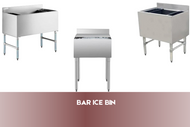BAR ICE BIN
1. Introduction – Why a Bar Ice Bin Matters
A bar ice bin is a specialized, refrigerated storage unit designed to hold large quantities of ice safely and efficiently, ensuring beverage professionals always have rapid access to clean ice for drinks. What may look like a simple cooler is actually a vital piece of commercial restaurant equipment, offering predictable performance, sanitation, and workflow efficiency—especially in the fast-paced environment of bars, restaurants, and catering operations.
2. Core Functionality
2.1 Sanitary Ice Storage
-
Keeps ice off counters and floors, minimizing contamination and safety risks.
-
Includes scoops or scoop holders to prevent touching ice by hand.
2.2 Temperature Control
-
Equipped with insulation and an active cooling system to keep ice solid even during service peaks.
-
Thermostatic controls maintain ideal storage temperature (below 32°F/0°C), avoiding mushy ice and reducing water pooling.
2.3 Speed & Accessibility
-
Designed with wide lids and sloped interiors to facilitate rapid ice retrieval with scoop or glove.
-
Some models include ergonomic scoop racks and drainage systems to remove meltwater, keeping workspace clean.
2.4 Durability & Install Flexibility
-
Constructed from stainless steel or heavy-duty plastic to resist spills, dings, and corrosion.
-
Countertop, underbar, or freestanding units fit various layout needs.
-
Includes adjustable legs or swivel casters for level setup and easy cleaning access.
3. Why Restaurants & Bars Need One
3.1 High-Volume Bars & Cocktail Lounges
-
Quick-paced bars rely on fast ice access. Flimsy containers cause service delays.
-
Ice bins guarantee bartender efficiency, minimizing disruptions during happy hour or nights.
3.2 Full-Service Restaurants
-
Offer drinks, water, iced tea, and cocktails. An accessible bin improves speed at point-of-sale locations.
-
Prevents cross-contamination by segregating ice from food prep zones.
3.3 Banquet Halls & Event Caterers
-
Large events require bulk ice for chilling and drink service. A mobile bin (on swivel casters) can be moved to service stations.
-
Keeps ice clean outdoors; built-in lids protect from heat, contaminants, insects.
3.4 Specialty Cafés & Smoothie Bars
-
Regular iced coffee/smoothie service needs clean ice storage near blenders.
-
A bin that keeps ice dry and chilled ensures a consistent beverage texture.
4. Benefits of a Bar Ice Bin
4.1 Efficiency & Speed
-
Fast ice access reshapes workflow and improves customer wait times.
-
Ideal layout ensures scoops are close to prep area.
4.2 Hygiene & Safety
-
Minimizes contamination with enclosed storage and touch-free tools.
-
Reduces spill and fall risks from loose ice.
4.3 Cost Savings
-
Prevents ice from melting, reducing waste and lowering supply costs.
-
Good insulation and energy-efficient refrigeration lower energy bills.
4.4 Durability
-
Commercial-grade materials withstand frequent use and cleaning.
-
Built-in components like drains and compressors reduce retrofit needs.
5. Integration with Commercial Restaurant Equipment
The bar ice bin is central to beverage service stations and counts as essential commercial restaurant equipment. Whether paired with back-bar fridges, glass washers, or sink stations, it ensures beverage prep keeps up with customer demands and sanitation requirements. Foodservice consultants specify them in layouts due to workflow and food safety standards.
6. Procurement in the U.S.: “Restaurant Equipment Dallas”
Ice bins are listed in catalogs for restaurant equipment Dallas, sold by distributors throughout the metroplex (Dallas–Fort Worth, Irving, Arlington). Both new and used restaurant equipment options are available—often from bars upgrading their setups. Reconditioned bins go through cleaning, sanitizing, compressor checks, and gasket replacement prior to resale.
7. New vs. Used Restaurant Equipment
7.1 New Ice Bins
-
Come with manufacturer warranties and technician installation.
-
Offer latest features: digital thermostats, LED lids, eco-friendly refrigerants, insulated drain systems.
-
Ideal for startups and expansion venues requiring reliability and support.
7.2 Used Restaurant Equipment
-
Cost-effective choices for second locations or smaller operations.
-
Always inspect for compressor function, gasket integrity, insulation condition, and absence of mold.
-
Attractive ROI for establishments that don’t need top-spec features but require functional equipment.
8. Return on Investment (ROI)
8.1 Operational ROI
-
Less wasted ice, faster service speed, and cleaner prep areas add up to cost and time savings.
-
Improves customer satisfaction which may translate to increased tips and repeat visits.
8.2 Environmental Impact
-
Energy-efficient and well-insulated bins reduce utility costs.
-
Reusing used restaurant equipment extends product lifespan and reduces landfill waste.
9. Maintenance & Best Practices
-
Daily: Drain condensation. Wipe interior/exterior with sanitizer.
-
Weekly: Empty all ice, scrub bin interior with mild detergent, rinse, air dry before refilling.
-
Monthly: Inspect drain lines, defrost if ice buildup occurs, clean condenser coils.
-
Biannual/Annual: Have HVAC technician inspect compressor, thermostat, gaskets, refrigerant. For used units—check refrigerant levels and certification.
10. Final Thoughts
A bar ice bin might seem simple, but in any commercial food or beverage venue it's foundational—boosting efficiency, hygiene, and service speed. Pair it with other commercial restaurant equipment, and it becomes a reliable station capable of enhancing bar output and guest satisfaction. For businesses in the Dallas–Fort Worth metro area, distributors offer both new restaurant equipment Dallas and well-refurbished used restaurant equipment, ensuring venues can match needs and budgets effectively. Choosing the right ice bin is a wise, long-term investment.

